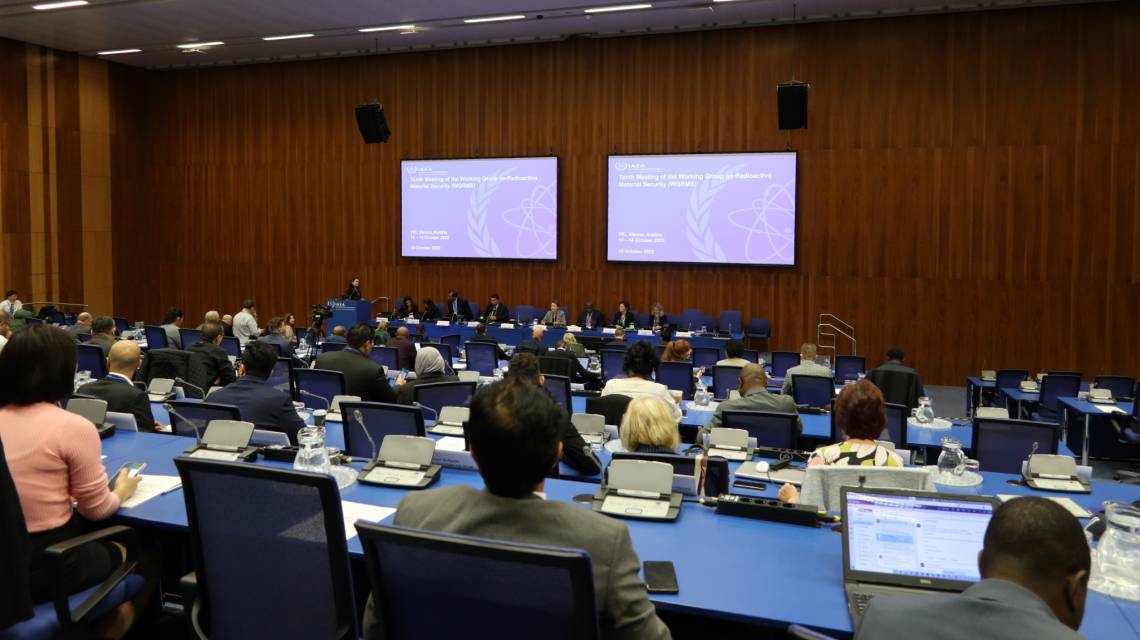"All about the security of radioactive material." This motto captures the discussions recently held among the IAEA experts and the working group on radioactive material security (WGRMS), who covered a range of issues related to the protection and control of radioactive material, towards promoting and enhancing nuclear security worldwide.
"The significant IAEA work for the security of radioactive material globally requires collaboration and commitment from all stakeholders," said Elena Buglova, Director of the IAEA Division of Nuclear Security, in her opening remarks. "For a decade now, the WGRMS has been providing consolidated input for improving planning and delivery of IAEA technical assistance to countries under the nuclear security programme."
The purpose of the WGRMS is to foster coordination, collaboration and communication among relevant stakeholders to optimize the delivery of the IAEA assistance related to the protection and control of radioactive material, including radioactive sources. The recent meeting marked one decade since the WGRMS' establishment.
Over eighty participants from 60 countries and two organizations discussed the latest developments in various technical areas, including updates about nuclear security guidance and large-scale projects such as one on sustainable management of disused sealed radioactive sources (DSRS). National experts presented case studies, and shared good practices, such as the inclusion of financial provisions for the management of newly acquired sealed radioactive sources once they reach the end of their useful life.
Representatives from Brazil presented a novel theoretical model for applying optimized nuclear security measures at facilities, based on identified vulnerabilities and a graded approach, and participants from the United States of America shared a thought-provoking video showcasing the evolving perspective on threats posed by people with authorized access to facilities handling radioactive material, known as insider threats.
"The highly interactive case study sessions showed the possibility, but also the reality of malicious actions involving radioactive material, thus allowing a better appreciation of the need to establish a robust security regime in our countries," said Moustapha Tall, Chair of the meeting and Director of Inspections in the Radiation Protection and Nuclear Safety Authority (ARSN) of Senegal. "The lively discussions and information sharing made it possible to identify approaches to strengthen cooperation and coordination in order to improve the security of radioactive sources worldwide," Tall added.
Among the most popular sessions were those related to the role of technology in assisting the security of radioactive material, such as the emerging role of computer security for the protection of radioactive material against theft and the devices utilizing them against sabotage.
Participants were provided with in depth information on the IAEA's integrated approach for radiation safety and security of radioactive material for the efficient management of radioactive sources, and specifically about the launch of a new Advisory Mission on Regulatory Infrastructure for Radiation Safety and Nuclear Security (RISS), and the implementation of Regulatory Infrastructure Development Projects (RIDP) in Africa, in the Caribbean and Latin America.
Learning from each other to further improve nuclear security

The international experts of the Working Group on Radioactive Material Security convened for their first in-person meeting after the Covid-19 pandemic. (Photo: A. Rahandini/IAEA)
When the first meeting of the Working Group on Radioactive Material Security was convened in Vienna in November 2012 - originally referred to as the Working Group on Radioactive Source Security - representatives from around 20 countries participated. Since then, the participation numbers kept increasing confirming the growing interest in this area.
"One of the early goals of the group was to bring together countries with needs and countries who can offer support to discuss how the needs can be most effectively met," said William A. Lorenzen, Radiation & Health Physicist at Boston Children's Hospital reflecting on the Group's work. "As an operator I have welcomed the opportunity to provide this forum with the perspectives of the industry that is impacted by these regulatory programs and initiatives. I have found the exchanges extremely beneficial," he said. "Since my initial involvement in 2015 when there were only a handful of participating countries, the WGRMS has advanced the interest of many more countries."
The WGRMS meetings serve as a forum to exchange experiences and to identify approaches to strengthen cooperation and coordination for enhanced security of radioactive material worldwide. "Over the last few years, the WGRMS has evolved into a global forum for fruitful technical exchanges," said Alessia Rodriguez y Baena, who has been serving as IAEA Scientific Secretary for the group since 2018. "This forum engages experts, often with quite diverse experiences and views, from all over the world in constructive dialogue which is refreshing both under the professional and human perspective."
Security Management of Radioactive Material in Use and Storage and of Associated Facilities
The technical guidance No.43-T "Security Management of Radioactive Material in Use and Storage and of Associated Facilities" - is the latest Nuclear Security Series document with regard to the nuclear security of radioactive material published by the IAEA earlier this year. The new guidance focus areas are management aspects, like the policies, plans, procedures and processes, which are paramount for the security of radioactive material.
Training material is currently under preparation by the IAEA and is expected to be piloted next year.






